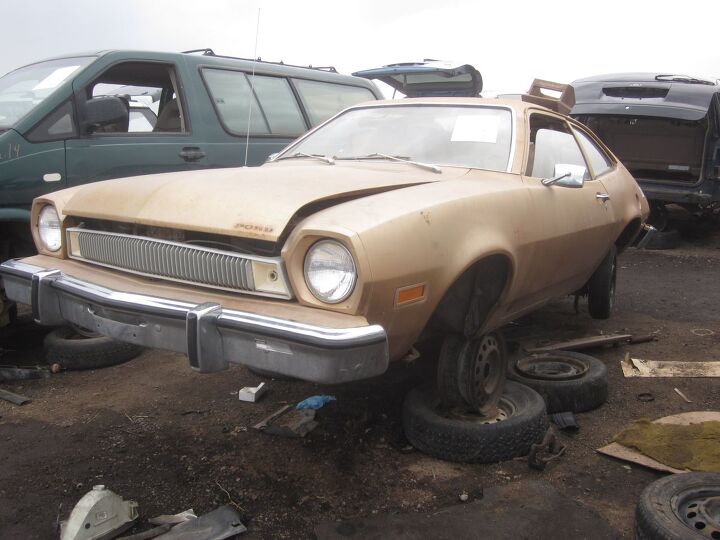Junkyard Find: 1974 Ford Pinto

There was a time, let’s say in the late 1980s, when the quantity of Pintos in junkyards went from “glut” to “famine,” as if a switch was flipped and all the Pintos just disappeared. The same thing happened with the early Hyundai Excel, too, only they lived, died, and got scrapped within a five-year period versus the 10-to-15-year period for the Pinto. Still, every so often I find a lone Pinto that hung on an extra couple of decades before getting junked. For example, this tan ’74 that showed up in a Denver self-service yard last month.
This car has all the hallmarks of long-term outdoor storage in Colorado, including completely obliterated upholstery and much-faded paint.
It appears to have been damaged and then Bondo’d in its early career.
This engine family had an exceptionally long run, making it into the 21st century.
In spite of all the legends about “exploding Pintos,” these cars really didn’t suffer from fuel tank fires much more often than other rear-drive vehicles with the gas tank between the rear axle and the bumper (i.e., just about every single vehicle sold by Detroit at the time). The problem was the infamous “ Ford Pinto Memo,” which resulted in Ford taking a couple of big public-relations black eyes by appearing not to care about Pinto passengers getting burned to a crisp. Next thing you know, everybody knows someone who knows someone who died in a Pinto explosion.
I spent a lot of my teen years riding in Pintos, this being one of the most popular hand-me-down cars given to my peers by cheapskate parents in the early 1980s, and at least I can say it was better than the wretched Chevy Vega.

Murilee Martin is the pen name of Phil Greden, a writer who has lived in Minnesota, California, Georgia and (now) Colorado. He has toiled at copywriting, technical writing, junkmail writing, fiction writing and now automotive writing. He has owned many terrible vehicles and some good ones. He spends a great deal of time in self-service junkyards. These days, he writes for publications including Autoweek, Autoblog, Hagerty, The Truth About Cars and Capital One.
More by Murilee Martin
Latest Car Reviews
Read moreLatest Product Reviews
Read moreRecent Comments
- Jalop1991 In a manner similar to PHEV being the correct answer, I declare RPVs to be the correct answer here.We're doing it with certain aircraft; why not with cars on the ground, using hardware and tools like Telsa's "FSD" or GM's "SuperCruise" as the base?Take the local Uber driver out of the car, and put him in a professional centralized environment from where he drives me around. The system and the individual car can have awareness as well as gates, but he's responsible for the driving.Put the tech into my car, and let me buy it as needed. I need someone else to drive me home; hit the button and voila, I've hired a driver for the moment. I don't want to drive 11 hours to my vacation spot; hire the remote pilot for that. When I get there, I have my car and he's still at his normal location, piloting cars for other people.The system would allow for driver rest period, like what's required for truckers, so I might end up with multiple people driving me to the coast. I don't care. And they don't have to be physically with me, therefore they can be way cheaper.Charge taxi-type per-mile rates. For long drives, offer per-trip rates. Offer subscriptions, including miles/hours. Whatever.(And for grins, dress the remote pilots all as Johnnie.)Start this out with big rigs. Take the trucker away from the long haul driving, and let him be there for emergencies and the short haul parts of the trip.And in a manner similar to PHEVs being discredited, I fully expect to be razzed for this brilliant idea (not unlike how Alan Kay wasn't recognized until many many years later for his Dynabook vision).
- B-BodyBuick84 Not afraid of AV's as I highly doubt they will ever be %100 viable for our roads. Stop-and-go downtown city or rush hour highway traffic? I can see that, but otherwise there's simply too many variables. Bad weather conditions, faded road lines or markings, reflective surfaces with glare, etc. There's also the issue of cultural norms. About a decade ago there was actually an online test called 'The Morality Machine' one could do online where you were in control of an AV and choose what action to take when a crash was inevitable. I think something like 2.5 million people across the world participated? For example, do you hit and most likely kill the elderly couple strolling across the crosswalk or crash the vehicle into a cement barrier and almost certainly cause the death of the vehicle occupants? What if it's a parent and child? In N. America 98% of people choose to hit the elderly couple and save themselves while in Asia, the exact opposite happened where 98% choose to hit the parent and child. Why? Cultural differences. Asia puts a lot of emphasis on respecting their elderly while N. America has a culture of 'save/ protect the children'. Are these AV's going to respect that culture? Is a VW Jetta or Buick Envision AV going to have different programming depending on whether it's sold in Canada or Taiwan? how's that going to effect legislation and legal battles when a crash inevitibly does happen? These are the true barriers to mass AV adoption, and in the 10 years since that test came out, there has been zero answers or progress on this matter. So no, I'm not afraid of AV's simply because with the exception of a few specific situations, most avenues are going to prove to be a dead-end for automakers.
- Mike Bradley Autonomous cars were developed in Silicon Valley. For new products there, the standard business plan is to put a barely-functioning product on the market right away and wait for the early-adopter customers to find the flaws. That's exactly what's happened. Detroit's plan is pretty much the opposite, but Detroit isn't developing this product. That's why dealers, for instance, haven't been trained in the cars.
- Dartman https://apnews.com/article/artificial-intelligence-fighter-jets-air-force-6a1100c96a73ca9b7f41cbd6a2753fdaAutonomous/Ai is here now. The question is implementation and acceptance.
- FreedMike If Dodge were smart - and I don't think they are - they'd spend their money refreshing and reworking the Durango (which I think is entering model year 3,221), versus going down the same "stuff 'em full of motor and give 'em cool new paint options" path. That's the approach they used with the Charger and Challenger, and both those models are dead. The Durango is still a strong product in a strong market; why not keep it fresher?


















































Comments
Join the conversation
Ah, yet another domestic tragedy that informed my youth. My dad had a forest green Pinto for a few years in the '80s. My memories of it revolve around how much of a torture chamber the interior was in the warmer months. The vinyl seats were awful, the whole car was an oven in sunlight, and I burned my hand on the seat belt buckle one summer day. A pregnant deer sacrificed itself one morning to send that car to hell.
Did that Pinto happen to have an overengineered XR2200 muffler bracket?